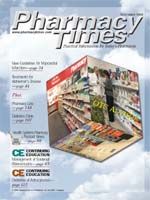Publication
Article
Pharmacy Times
Counseling Patients on OTC Drugs
Author(s):
The involvement of pharmacistsin nonprescription medicationcounseling will increase the public'sability to understand the risks andbenefits of OTC remedies. It has beenwell documented that interactions bypharmacists through consultation andeffective assessment strategies canenhance patient outcomes. In order tocounsel patients efficiently, pharmacistsmust be able to communicate.
One way to ensure understanding isthrough active listening, a process inwhich the receiver repeats the informationback to the sender. This processfosters information exchange and promoteseffective learning. The first stepin achieving optimal communicationis setting the stage. By identifyingpotential barriers in the pharmacy thatcan impede good communication,pharmacists can actively take steps toovercome them. It is important toremove distractions or barriers thatmay affect interactions with patients.
Potential Barriers to PatientConsultation
Several barriers exist in a communitypharmacy environment. The 3 mostcommon are barriers from the pharmacyenvironment, barriers arising fromthe pharmacist, and barriers stemmingfrom the patient.
Pharmacy Environment
The design of a pharmacy has amajor impact on how patients viewpharmacists and react to their consultationefforts. Environmental barrierspresent a challenge for all pharmacist?patient interactions. For example,the presence of a high counter preventseasy eye contact and makes apharmacist seem aloof and even uncaring.The lack of semiprivate spacedeters patients from asking questionsof their pharmacist or describing problems.
To overcome these types of environmentaland physical barriers, the pharmacistshould come out from behindthe dispensing area to consult withpatients and communicate face to face.By sitting or standing at eye level orlower, the pharmacist does not seemthreatening, and that stance openslines of communication.1 If it is notpossible for the pharmacist to comeout from behind the counter, he or sheshould attempt to minimize the barrierproduced by the counter by focusingon the patient.
Pharmacist Barriers
Other barriers also can impede pharmacist?patient communication. Suchbarriers include inappropriate use ofinterpersonal space by the pharmacist,inappropriate body language, or inappropriatevocal characteristics. Correctiveactions for these kinds of barrierscan be remembered by Muldary'sacronym, "CLOSER" (Table 1).2
Patient Barriers
Patients also can create barriers thatpharmacists must recognize. Functionalbarriers hinder the patient's abilityto understand information that isbeing communicated by the pharmacist.Examples of functional barriers arelisted in Table 2.
Sensory deficits include blindness,deafness, or other visual impairments.Whereas some barriers are easily recognizedthrough common sense, environmentalbarriers that are of relevanceonly to some individuals maynot be obvious. For example, patientswith poor vision may have difficultyreading OTC labels. During patientconsultation, the pharmacist shouldassess how the pharmacy environmentaffects communication with thepatient and take steps to minimize anybarriers when possible.
In addition, language differences canbe a frustrating barrier when counselinga patient about an OTC agent. Typically,children will accompany anolder member of the family, and theycan be used to help translate. In addition,bilingual police officers may beavailable in some areas to help. Providingwritten sheets along with verbalcommunication may help facilitatecommunication. Also, using picturesmay be beneficial.
Functional illiteracy and low healthliteracy affect counseling about nonprescriptionagents. Patients who arefunctionally illiterate are difficult toidentify because they often try to hidetheir inability to read or write. Patientswith low health literacy have difficultyunderstanding disease-related information,medication information, anddirections. These types of problems canlead to medication errors and worsenpatient outcomes.
Comprehension difficulties can arisefrom dementia, psychiatric conditions,or mental retardation. Whatever thecause, the patient's inability to understandmedication instructions may bedifficult to overcome. Having a caregiverpresent can help with communication.
A patient's alternative health beliefsand personal health beliefs also can befunctional barriers. Patients who havea different set of beliefs from Westernmedicine can be difficult to identify.Some signals that may alert pharmaciststo this barrier include poor adherenceand persistent questioning aboutan effect of a medicine.
Several books have been writtenabout cultural differences in healthcare. This subject requires sensitivityon the part of the pharmacist. If possible,pharmacists should educate themselvesabout the beliefs of the people inthe cultures they serve. This informationcan be used to avoid negativeinteractions and help support the communicationpharmacists will have withpatients.
Overcoming Barriers
In addition to Muldary's acronym,other techniques can be utilized tofacilitate understanding and open linesof communication between pharmacistsand patients.
Pharmacists should keep the followingtips in mind:
- Be an active listener
- Use clear, unambiguous language appropriate to the knowledge of the patient
- Be cognizant of nonverbal cues
- Ask for feedback so as to clarify any misunderstandings
- Provide feedback, outlining the message
Some common barriers to active listeningare multitasking, selectively listeningto the patient, having internalmonologue or planning one's nextpoint while the patient is speaking,leaping ahead to make a conclusion,listening with one's ears only, or beingtoo quick to jump in. Pharmacists needto recognize these obstacles to nonprescriptioncounseling and take steps toovercome them.
Pharmacists are the nonprescriptionmedication experts. Patients recognizethis fact and typically use pharmacistsas first-line sources of drug information.In order for pharmacists to nurturethe relationships they have withpatients, they must set the stage foroptimal communication by usingactive listening, minimizing environmentalbarriers, eliminating pharmacistbarriers, and overcoming patientbarriers that may make counselingmore difficult.
Dr. Ferreri is a clinical assistant professor atthe University of South Carolina School ofPharmacy.
For a list of references, send a stamped,self-addressed envelope to: References Department,Attn. A. Stahl, Pharmacy Times,241 Forsgate Drive, Jamesburg, NJ 08831;or send an e-mail request to: [email protected].

Newsletter
Stay informed on drug updates, treatment guidelines, and pharmacy practice trends—subscribe to Pharmacy Times for weekly clinical insights.






